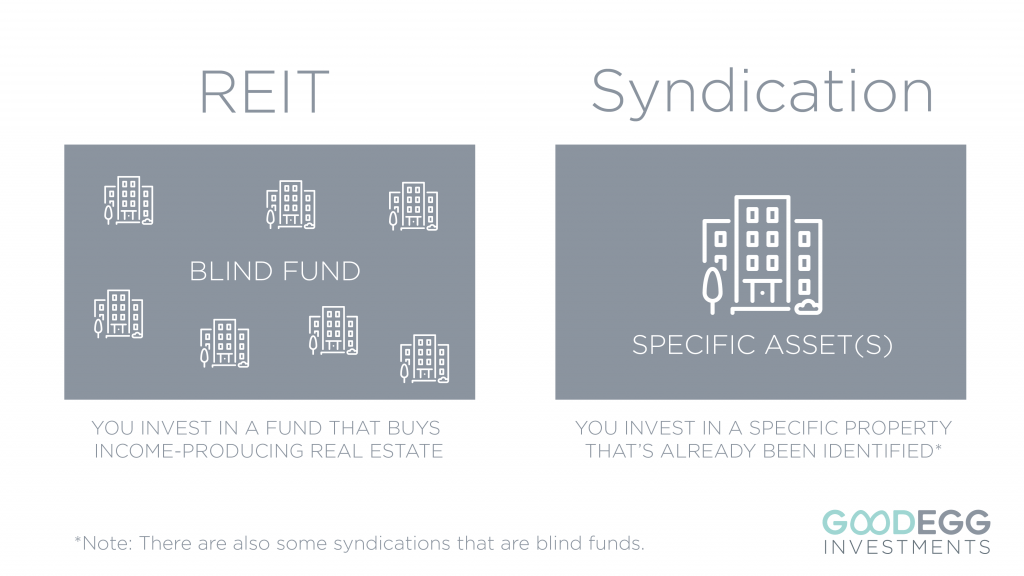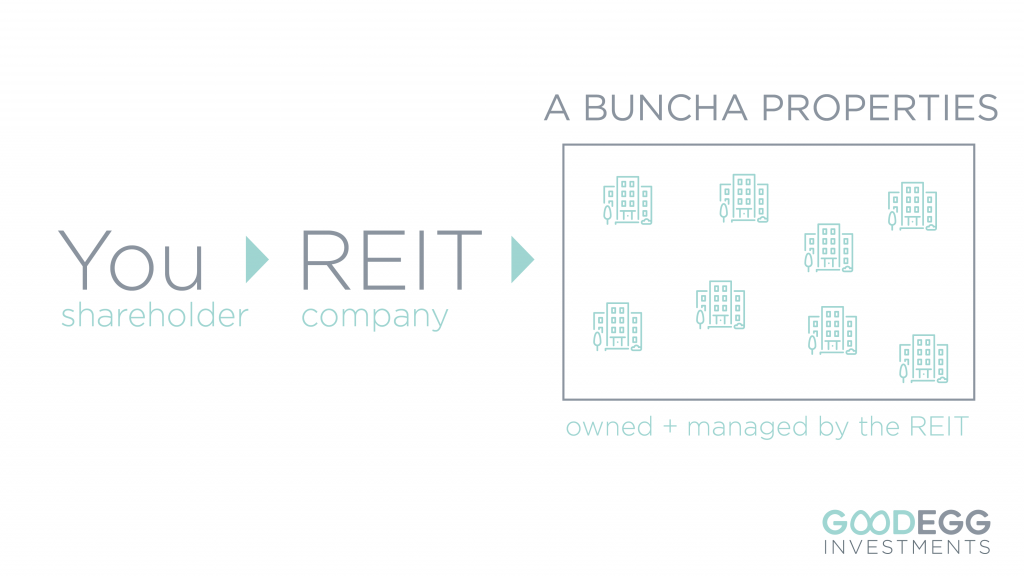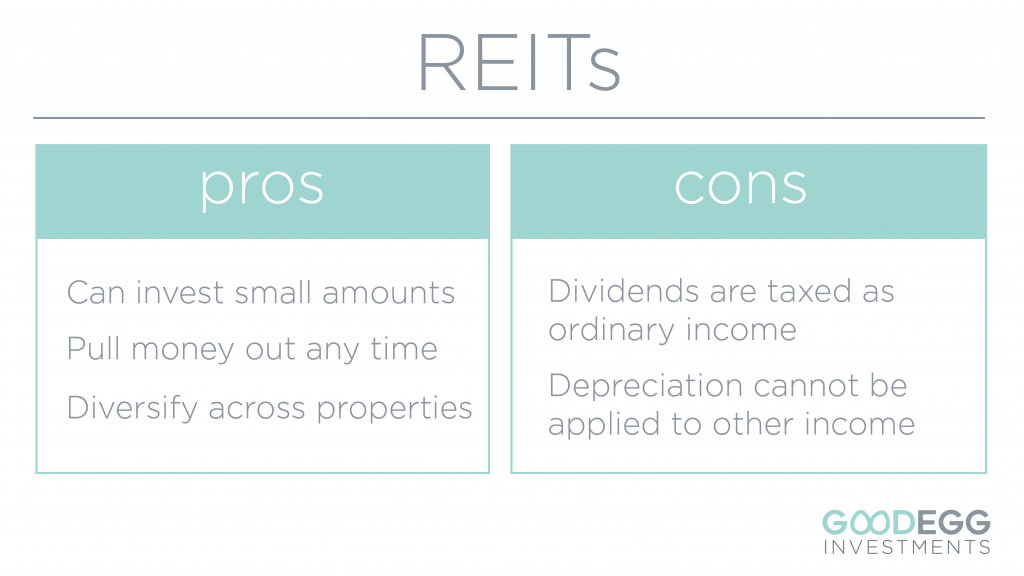If you’re like many investors, you want to put your money into real estate and reap the benefits of passive income, but you don’t want to be a landlord. Something about fixing toilet emergencies at 3am just doesn’t appeal to you. Go figure.
The next logical step that many investors take is to invest in REITs, or real estate investment trusts. After all, many REITs are publicly traded, so they’re easy to access and invest in, just like stocks. Surely that must mean that real estate investment trusts are just as good as investing in individual real estate assets…right?
That’s exactly what we’ll cover in this article. We’ll walk through the ins and outs of REITs, how they compare to real estate syndications, and how to find the best fit for you.
What Is A REIT?
A REIT, or a real estate investment trust, is a company that invests in income-producing commercial real estate. So, logically, if a REIT invests in apartments, and you invest in that REIT, it’s like you’re investing directly in an apartment building, right?
Not so fast. But you knew it wouldn’t be that easy.
There are some major differences between investing in REITs vs. investing directly in real assets. Let’s explore the main differences between a REIT and a real estate syndication (i.e., a group investment).
Here are the seven biggest differences between a REIT and a real estate syndication:
- Number of Assets
- Ownership
- Access to Invest
- Investment Minimums
- Liquidity
- Tax Benefits
- Returns
Difference #1: Number of Assets
With a REIT, you are typically investing in a company that holds a portfolio of properties across multiple markets. Each REIT focuses on certain asset classes, like apartment buildings, shopping malls, office buildings, elderly care, etc.
That means that if you invest in an apartment REIT, it will likely own and manage a lot of apartment buildings in multiple markets across the country. You don’t get a say in which apartments the REIT purchases, but it could be great for diversifying your investment portfolio.
On the flip side, with most real estate syndications, you are investing in a single property in a single market. You will know exactly where the property is, where the nearest Starbucks is, how many units are included, all the financials specific to that property, and what the business plan is.

Difference #2: Ownership
When you invest in REITs, you are buying shares in a company, just like when you buy shares in Facebook or Apple. You do not own the underlying real estate. Rather, you own shares in the company that owns those assets.

When you invest in a syndication, or a group investment, you are investing directly in a specific property. That means that, together with the other limited partner investors and general partners, you will own the entity (usually an LLC) that holds the asset. Thus, you have direct ownership.

Difference #3: Access to Invest
The majority of REITs are listed on major stock exchanges, just like any other public stock. You can invest in REITs directly, or you can invest through mutual funds or exchange-traded funds. Because most REITs are publicly listed, they are easy to find and to invest in.
Got $100 to invest? You can probably invest in a REIT within the next ten minutes. Done and done.
Real estate syndications, on the other hand, can be more difficult to find, and the process to invest can involve a bit more time and effort. Many real estate syndications are under an SEC regulation that disallows public advertising. As such, you would need to be connected with someone who’s got a deal you can invest in.
The process of investing in a real estate syndication usually takes not a few minutes, but rather, a few weeks. This includes time to review the investment opportunity, sign the legal documents, and send in your funds. Once you invest in the deal, you will likely start seeing ongoing passive income as soon as the month right after the property closes.
Further, many real estate syndications are only open to accredited investors, which can be an additional hurdle for some investors.
Difference #4: Investment Minimums
Just as when you buy stocks, when you invest in a REIT, you are purchasing shares, some of which can be just a few bucks. Thus, this method of real estate investing (that is, investing in a REIT) can be done with a very small amount of money, which makes it quite appealing to many investors, particularly those just getting started with real estate investing.
On the flip side, syndications typically have higher minimum investments. Often the minimum investment amount is $50,000, though the minimums for each real estate investment can vary and can be as low as $10,000, and as high as $100,000 or more. Thus, you will need quite a bit more capital to invest in a real estate syndication.
Difference #5: Liquidity
This is another aspect in which REITs reign supreme. Just as when you invest in stocks, REITs keep your investment liquid. That means that at any time, you can buy or sell shares, and your money is not locked in for a set amount of time.
When you invest in a real estate syndication, you are investing directly in a real piece of property. Just like when you buy a home, you can’t buy and sell that with the click of a button. The same applies for real estate syndications. The business plan often includes holding the asset for a certain amount of time, during which your money would be illiquid.
So if you’re thinking of investing $50,000 but may need some of that in a couple of years when Junior goes off to college, probably best not to put that into a real estate syndication, where that money will be locked in for a set amount of time.
Difference #6: Tax Benefits
One of the biggest benefits of investing in real estate is the tax benefits. When you invest directly in a property, you get the benefit of a variety of tax deductions, including depreciation (i.e., writing off the value of an asset over time). In some cases, particularly with accelerated depreciation, those tax benefits can be quite substantial.
In many of the investments in our portfolio, the depreciation benefits alone are reason enough to invest. The depreciation benefits often surpass the cash flow, so you’re showing a loss on paper while you’re actually getting positive cash flow. Further, you can use those paper losses to offset your other income, like income from your job.
When you invest in a REIT, because you’re investing in the company and not directly in the real estate, the tax benefits are a bit less exciting. You do get the benefits of depreciation, but those are factored in before you get your dividends, so you don’t get any tax breaks on top of that, and you can’t use that depreciation to offset any of your other income.
Further, any dividends are taxed as ordinary income, which can contribute to a bigger, rather than smaller, tax bill.
Difference #7: Returns
Let me first say, that returns for each individual investment can vary wildly, depending on the assets, the people, and the timing.
That being said, when looking at historical data over the last forty years, total returns for exchange-traded U.S. equity REITs averaged 12.87 percent per year. By comparison, stocks averaged 11.64 percent per year over that same period.
This is pretty good. This means that, on average, if you were to invest $100,000 in a REIT, you could expect somewhere around $12,870 per year in dividends.
For the multifamily real estate syndications we offer our investors, though, we typically set our sights a bit higher. When factoring in both cash flow and profits from the sale of the asset, our investments typically offer upwards of 20 percent average annual returns.
If you were to invest in a real estate syndication with a hold period of five years and a 20 percent average annual return, you would essentially be making $20,000 per year for 5 years, or $100,000 (this takes into account both cash flow and profits from the sale).
That means that you would double your money, from $100,000 to $200,000, over the course of those five years.
So, Which One Should You Invest In?
Well, there you have it, the seven biggest differences between a REIT and a real estate syndication:
- Number of Assets
- Ownership
- Access to Invest
- Investment Minimums
- Liquidity
- Tax Benefits
- Returns
All in all, there’s no one best investment for everyone (but you knew we were going to say that, right?).
If you had $1,000 to invest and wanted to be able to access that money freely, you might invest it into a REIT. If you had a bit more to invest and wanted direct ownership and more tax benefits, you might be more interested in a real estate syndication.
Now that you know some of the biggest differences between a REIT and a real estate syndication, you can weigh the pros and cons against your personal investing goals and decide.
And remember, it doesn’t have to be one or the other. You might start in a REIT and then invest in a real estate syndication later on. Or you might dabble a bit in both to diversify. Either way, investing in real estate, whether directly or indirectly, is always a win in our book.
Want To Learn More?
Now that you’re well-versed on the differences, you might be interested in digging deeper. If you’re interested in learning more about passive real estate investing and how to build true wealth for your family, we invite you to join the Goodegg Investor Club.






